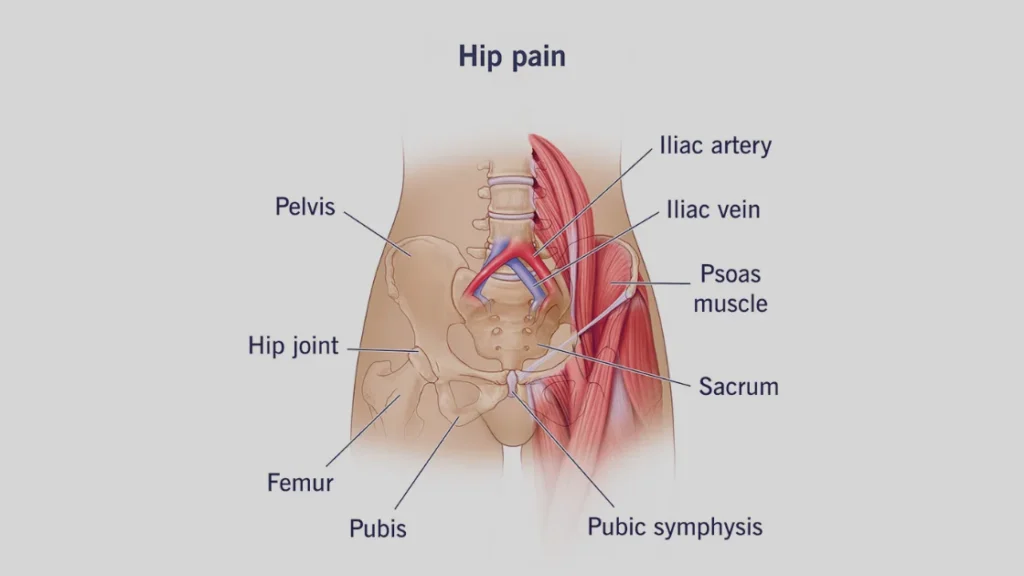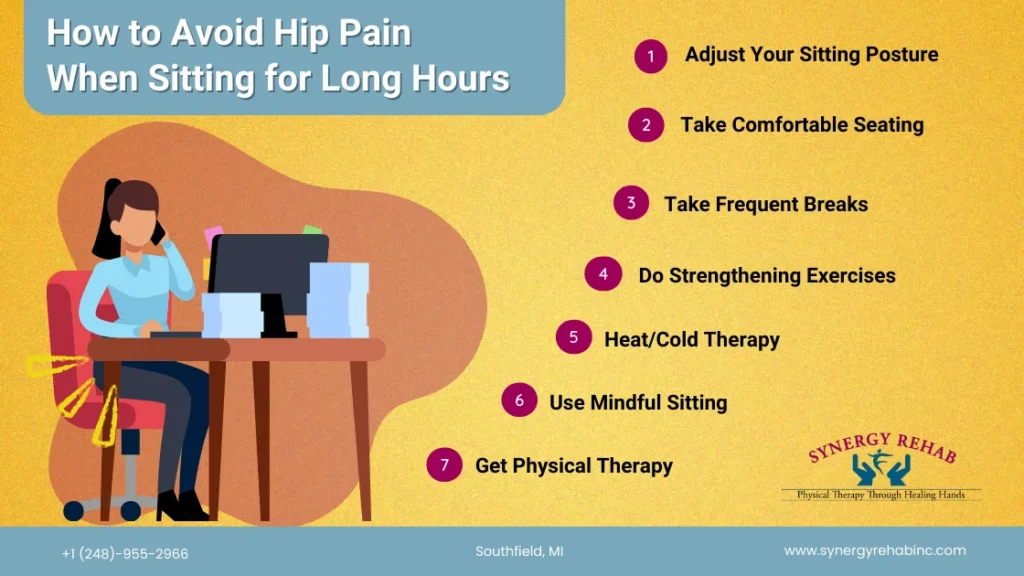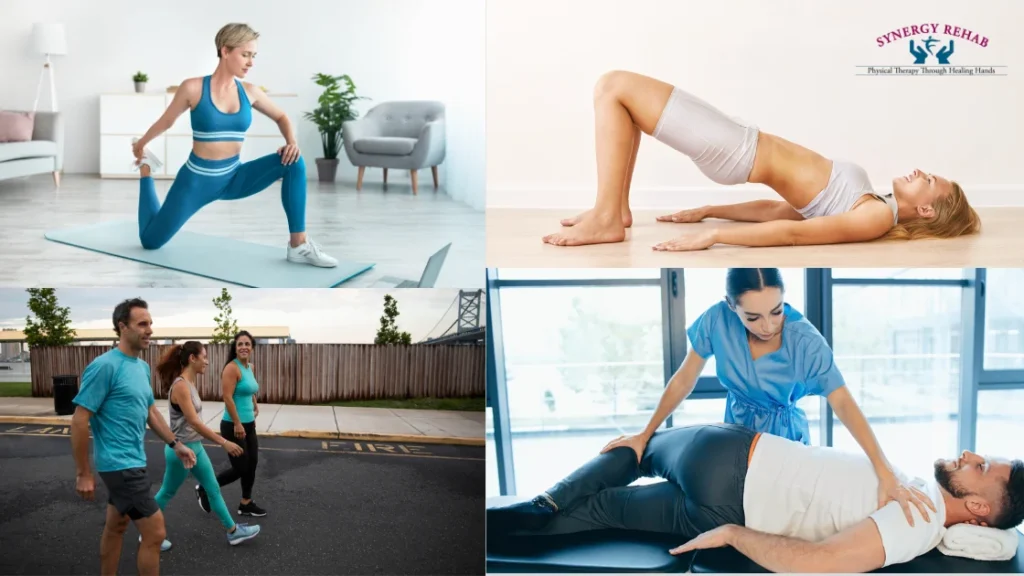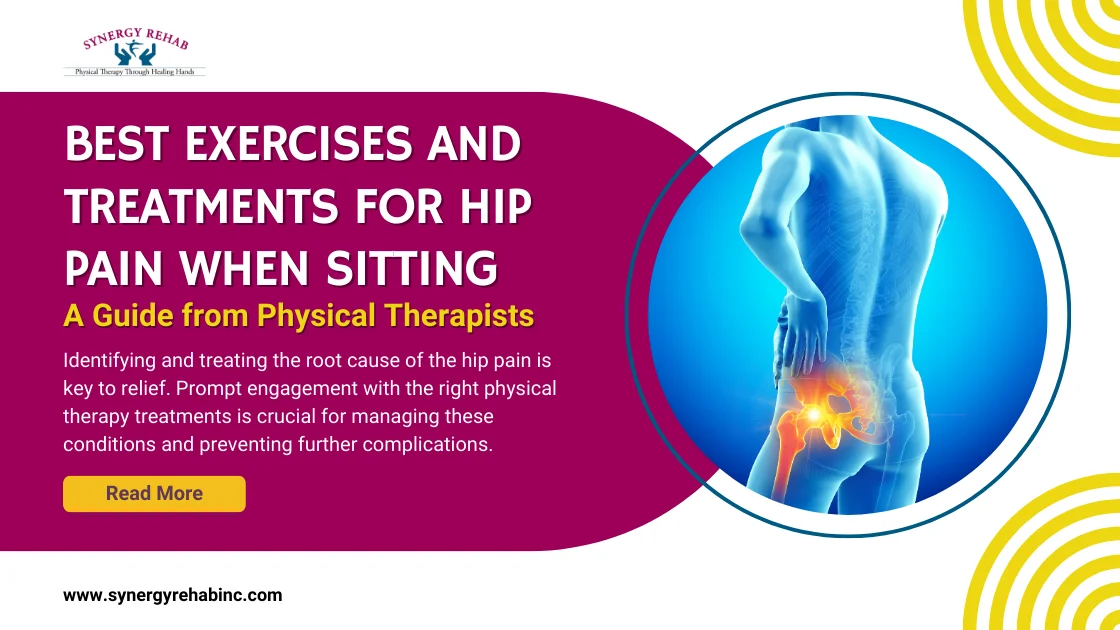Are you experiencing hip pain when sitting? Identifying and treating the root cause is key to relief. Common culprits include arthritis, hip bursitis, tendonitis, lupus, and piriformis syndrome, which could lead to lasting joint damage if neglected. Prompt engagement with the right physical therapy treatments is crucial for managing these conditions and preventing further complications.
Recognizing Hip Pain While Sitting
The hip joint, one of the body’s largest joints, supports the weight of the upper body, providing stability while allowing for a wide range of motion.
Pain in this area can arise from various factors, including poor posture, prolonged periods of sitting, overuse, or underlying health conditions such as arthritis or bursitis.

Image Source: Cleveland Clinic
If you have pain or discomfort when sitting in your groin area or inside your hip, it may be a sign of a hip bone or joint health problem.
Why Does My Hip Hurt When I Sit?
Multiple things may cause your hip soreness. This guide will provide you with information on controlling or reducing hip pain as well as assistance in understanding these possible reasons.
Hip Bursitis: Bursae are small, fluid-filled sacs that provide cushioning for bones and tendons. When these become inflamed, it can lead to sharp or achy pain in the hip area, especially when lying down or pressing on the affected side.
Poor Posture: Sitting or standing with poor posture can lead to hip pain over time. Slouching or hunching forward puts extra pressure on the hip joints, leading to strain and discomfort. Maintaining a neutral spine position helps distribute body weight evenly, reducing stress on the hips.
Tendinitis: The tendons, which are thick bands connecting muscles to bones, can become inflamed due to overuse or strain. This inflammation, known as tendinitis, causes pain and tenderness outside the hip joint.
Crossing Your Legs: Regularly crossing your legs while sitting can contribute to hip pain by altering the alignment of your hips and pelvis. This habit can strain the muscles and ligaments around the hip joint, leading to imbalances and discomfort.
Lupus: An autoimmune disease where the body’s immune system attacks its own tissues, causing widespread inflammation. This can affect various parts of the body, including the hip joint, leading to pain and stiffness.
Piriformis Syndrome: This occurs when the piriformis muscle, located in the buttocks near the top of the hip joint, irritates or compresses the sciatic nerve. Symptoms include pain, tingling, or numbness in the buttocks that can extend down the leg.
Arthritis: This condition is characterized by the wearing down of cartilage in the hip joint, leading to pain and stiffness. Over time, arthritis can cause the joint to become inflamed and sore, making movement challenging.
The hip joint can be affected by various types of arthritis, including:
- Osteoarthritis: Often related to aging or wear and tear, it’s the most common form.
- Rheumatoid Arthritis: An autoimmune condition that causes inflammation of the joints.
- Ankylosing Spondylitis: Primarily affects the spine but can also impact the hips.
- Psoriatic Arthritis: Linked with psoriasis, it can cause joint pain and stiffness.
- Septic Arthritis: Caused by infection, leading to severe pain and swelling in the hip joint.
Symptoms of Hip Pain
Symptoms of hip pain can vary but typically include:
- Discomfort in the hip, groin, thigh, or buttocks
- Stiffness limiting movement
- Swelling and tenderness in the hip area
- Reduced range of motion
- Pain worsens with activity, especially after sitting or walking
Why are my Hips Stiff After Sitting?
Hips can become stiff after sitting due to prolonged inactivity, leading to tightened muscles and restricted blood flow around the hip joint.
As we get older, the cartilage in the hip joint may wear down, and muscles tend to lose their elasticity, leading to increased stiffness. Additionally, conditions like osteoarthritis become more common with age, further exacerbating hip stiffness and discomfort.
Regular physical activity, stretching, and maintaining a healthy lifestyle can help manage and alleviate these age-related changes.
How to Manage Hip Pain When Sitting

Managing hip pain while sitting involves adopting the correct posture and engaging in regular, targeted exercises. These strategies help reduce the stress on your hips, enhancing comfort and mobility during prolonged periods of sitting.
To manage hip pain effectively when sitting:
Adjust Your Sitting Posture: Achieving and maintaining a proper sitting posture helps distribute your body weight evenly, reducing undue stress on your hip joints. Ensuring your feet are flat and your pelvis is neutral helps prevent hip tilt and strain.
Get Comfortable Seating An ergonomic chair supports your body’s natural posture, particularly your spinal curves, and keeps your hips at an optimal angle, reducing the risk of developing pain due to poor sitting habits.
Take Frequent Breaks: Regularly standing up and engaging in simple stretches or walks can boost blood flow, decrease muscle stiffness, and prevent hip pain associated with prolonged sitting.
Do Strengthening Exercises: Exercises focusing on hip flexors, glutes, and core can fortify the muscles around your hips, offering better support and reducing the likelihood of pain.
Heat/Cold Therapy: Applying heat helps relax tight muscles, while cold therapy can reduce inflammation and pain. This therapeutic approach provides immediate relief and can be easily incorporated into your daily routine.
Use Mindful Sitting: Being mindful of your sitting habits, like avoiding crossing your legs or sitting on uneven surfaces, can help maintain proper hip alignment and prevent pain from developing or worsening.
Get Physical Therapy: Engaging in regular physical activity helps maintain joint lubrication and strengthens muscles around the hips, easing strain. Physical therapists can assess your condition and prescribe specific exercises for improvement.
Why Doctors Recommend Physical Therapy for Hip Pain when Sitting
Doctors highly recommend physical therapy for hip pain when sitting because it offers a holistic approach to addressing the underlying causes of discomfort. Physical therapists specialize in assessing musculoskeletal issues and designing personalized treatment plans to improve mobility, reduce pain, and enhance overall function.
Here are some reasons why doctors commonly suggest physical therapy for hip pain while sitting:
Personalized Care: Physical therapists create custom plans to address the specific issues causing hip pain while sitting, tailoring exercises to each person’s needs.
Non-Surgical Option: Physical therapy provides a non-invasive way to manage hip pain without surgery or strong medications, making it a preferred choice for many.
Better Movement: Through exercises and techniques, physical therapy aims to improve how well you can move your hips, reducing discomfort and making sitting easier.
Learn Prevention: Physical therapists provide you advice on how to sit correctly and steer clear of activities that exacerbate hip discomfort, enabling you to avert more issues.
Team Collaboration: Physical therapists work closely with doctors and other healthcare providers to ensure you receive comprehensive care, maximizing your chances of feeling better.
Types of Physical Therapy Treatments for Treating Hip Pain While Sitting

Stretching Exercises
Stretching improves hip joint flexibility and reduces muscle tension, offering significant hip pain relief during sitting. It also targets key areas such as the hip flexors, hamstrings, piriformis, and gluteal muscles. These prescribed stretches are designed to enhance range of motion and alleviate stiffness, making them a crucial part of managing discomfort effectively.
Strengthening Exercises
Increasing the strength of the muscles that support the hips improves stability and lessens strain when sitting. Hip abduction, adduction, extension, and core stability are all enhanced by exercises like squats, lunges, hip bridges, and clamshells.
Manual Therapy
Physical therapists‘ hands-on methods, such as joint mobilizations and soft tissue massages, enhance hip joint mobility and lessen discomfort in addition to strengthening and stretching activities for an all-encompassing course of care.
Walking
Walking as part of the program can help promote hip health even more by increasing muscle activation, blood flow, and joint mobility. Walking on a regular basis enhances the benefits of stretching and strengthening exercises by improving hip function overall and easing the discomfort of sitting.
Visit Synergy Rehab Physical Therapy for Hip Pain Treatment Today
With most people in the U.S. sitting around seven to eight hours a day, it’s no surprise hip pain is common. That’s why at Synergy Rehab, we offer physical therapy for hip pain, providing treatments that really work. Sitting less and moving more is key, but when pain strikes, our physical therapy can make a big difference.
Conclusion
Addressing hip pain when sitting is essential for maintaining a healthy, active lifestyle. Incorporating physical therapy, alongside exercises and mindful practices, can significantly improve your condition. Synergy Rehab specializes in physical therapy for hip pain, offering expert guidance and treatment plans tailored to your needs.
Embrace a more comfortable sitting experience and improve your hip health by visiting Synergy Rehab. Take the first step towards relief and recovery today.
Frequently Asked Questions
Q1. What are the common causes of hip pain when sitting?
Common causes include arthritis, hip bursitis, tendonitis, lupus, and piriformis syndrome, which can lead to stiffness and discomfort.
Q2. How can physical therapy help with hip pain while sitting?
Physical therapy provides targeted exercises and treatments to improve mobility, reduce pain, and address the root causes of hip discomfort.
Q3. Is it possible to completely get rid of hip pain?
Yes, with consistent physical therapy focused on tailored exercises and treatments, many individuals can achieve significant relief from hip pain.
Q4. Can crossing my legs while sitting worsen hip pain?
Yes, crossing your legs can alter hip and pelvis alignment, contributing to increased pain and discomfort.
Q5. Can stress contribute to hip pain when sitting?
Yes, stress can manifest physically and lead to muscle tension, which may exacerbate hip pain. Practicing relaxation techniques such as deep breathing, meditation, or mindfulness can help alleviate stress and reduce hip pain.
Q6. How important is hydration in managing hip pain?
Staying hydrated is essential for maintaining joint health and lubrication. Drinking an adequate amount of water throughout the day can help keep the hip joints hydrated and may reduce discomfort associated with hip pain.



